

Depression Just Below Tropical Storm Strength Over Far Eastern Tropical Atlantic. Tropical Depression (17L) - September 24th, 2011 Enhanced Image Track of TS 17L At 11:00 AM EDT (1500 UTC) the center of Tropical Depression Seventeen (17L) was located near latitude 11.0 north, longitude 26.7 west, about 305 miles (490 km) south-southwest of the southernmost Cape Verde Islands.
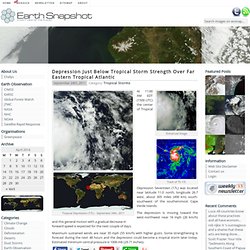
The depression is moving toward the west-northwest near 16 mph (26 km/h) and this general motion with a gradual decrease in forward speed is expected for the next couple of days. Maximum sustained winds are near 35 mph (55 km/h) with higher gusts. Alborz Mountains in Iran, South of Caspian Sea. Very Intense Hurricane Hilary (09E) Moving Away from Southwestern Coast of Mexico. Hurricane Hilary (09E) - September 23rd, 2011 Enhanced image Track of TS 09E At 2:00 PM PDT (2100 UTC), the eye of Hurricane Hilary (09E) was located near latitude 16.3 north, longitude 103.1 west.
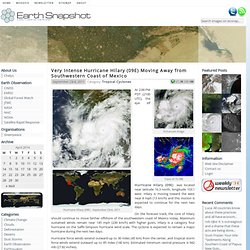
Hilary is moving toward the west near 8 mph (13 km/h) and this motion is expected to continue for the next two days. Popcorn Clouds Near Amazon River Mouth, Brazil. Brazil - September 21st, 2011 Popcorn clouds hovering in the skies over the Brazilian Amazon Rainforest help to highlight the channels of the Amazon River.
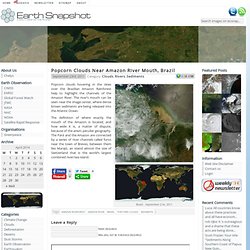
The river’s mouth can be seen near the image center, where dense brown sediments are being released into the Atlantic Ocean. The South Caucasus Region by the Caspian Sea. Georgia - September 9th, 2011 The Caucasus is a geopolitical region at the border of Europe and Asia.
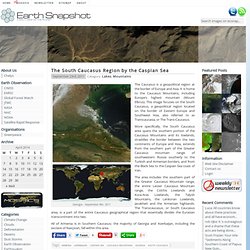
It is home to the Caucasus Mountains, including Europe’s highest mountain (Mount Elbrus). The Blue Nebula. Lakes Van, Urmia and Sevan, in Turkey, Iran and Armenia. Turkey and Iran - September 9th, 2011 Visible in this image are three lakes arranged in a triangle: Lake Van, in Turkey (left), the reddish Lake Urmia, in Iran (right), and Lake Sevan, in Armenia (above).

Each is the largest lake in its respective country. While Lakes Van and Sevan appear dark blue, Lake Urmia is rusty red in color. It is saline and ringed by salt flats that are white in color where its waters have (partially) evaporated. Lake Baikal During the Summer – September 23rd, 2011. Russia - September 18th, 2011 Lake Baikal is the world’s oldest and deepest lake at 30 million years old and with an average depth of 744.4 metres.
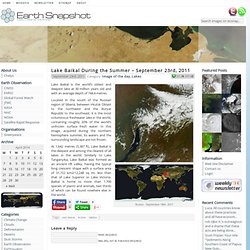
Tropical Storm Hilary (09E) Expected to Become Hurricane. Tropical Storm Hilary (09E) - September 21st, 2011 Enhanced image Track of TS 09E At 8:00 PM PDT (0300 UTC) the center of Tropical Storm Hilary (09E) was located near latitude 14.4 north, longitude 97.2 west.
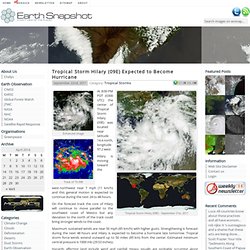
Hilary is moving toward the west-northwest near 7 mph (11 km/h) and this general motion is expected to continue during the next 24 to 48 hours. Contrails and Snow-Capped Alps in Europe – September 22nd, 2011. Italy - September 21st, 2011 This image focuses on Italy, with neighbors France, Switzerland, Germany, Austria, Hungary, Slovenia and Croatia also partially visible (clockwise from left).

The islands of Corsica (France, above) and Sardinia (Italy, below) can also be observed in the Mediterranean Sea. A Clue to the Secret of Dark Energy. ESO’s Very Large Telescope captured the first time-lapse movie of a rare shell ejected by a “vampire star.
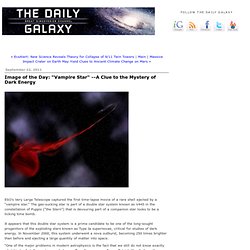
" The gas-sucking star is part of a double star system known as V445 in the constellation of Puppis ("the Stern") that is devouring part of a companion star looks to be a ticking time bomb. It appears that this double star system is a prime candidate to be one of the long-sought progenitors of the exploding stars known as Type Ia supernovae, critical for studies of dark energy. In November 2000, this system underwent a nova outburst, becoming 250 times brighter than before and ejecting a large quantity of matter into space. “One of the major problems in modern astrophysics is the fact that we still do not know exactly what kinds of stellar system explode as a Type Ia supernova,” says Patrick Woudt, from the University of Cape Town and lead author of the paper reporting the results. A supernova is one way that a star can end its life, exploding in a display of grandiose fireworks. Tropical Storm Roke (18W) North-northeast of Japan. Tropical Storm Roke (18W) - September 22nd, 2011 Enhanced image Track of TS 18W Tropical Storm Roke (18W), located approximately 90 nm north-northeast of Tokyo, Japan, has tracked northeastward at 31 knots over the past six hours.

Animated infrared satellite imagery indicates rapidly weakening deep convection, sheared northeast of the low-level circulation center. The bulk of the deep convection is now located over the northeast quadrant and also shows a weak frontal signature. TS 18W is undergoing extra-tropical transition (ETT) and is forecast to complete ETT by TAU 12 as it tracks rapidly northeastward. Galveston Bay and Sediments Along the Gulf of Mexico Coast, USA. USA - September 7th, 2011 Greenish sediments can be seen in the Gulf of Mexico along the coasts of Texas (left) and Louisiana (right), USA.
Several bays can be observed along the coastline, most of which are bright yellow-green in color. Lakes by Chile-Argentina Border and Tierra del Fuego. Argentina - August 16th, 2011 This image stretches across the Argentine province of Santa Cruz to Tierra del Fuego, shared by Chile and Argentina. Visible in the lower right corner is Mitre Peninsula, the easternmost part of Isla Grande de Tierra del Fuego. The land to the east is snow-free, while that to the west, by the Andes Mountains, is snow-covered. Visible amidst the snow are three bright blue lakes: Lake O’Higgins/San Martín, Lake Viedma and Lake Argentino (from north to south).
Green Mountains of Cyprus. Cyprus - August 16th, 2011 Visible in the Mediterranean Sea south of Turkey and west of Syria and Lebanon is the island-nation of Cyprus. Strange Quantum Star Found in Supernova. However, Prashanth Jaikumar and his fellow researchers from the Argonne National Laboratory in Illinois, and two colleagues from Los Alamos National Laboratory in New Mexico, Sanjay Reddy and Andrew W. Steiner, have challenged that. The team developed a theory about what a strange star would look like. "We haven't found strange stars yet," Jaikumar explains. "But that doesn't mean they don't exist. Maybe we have found them. One of the most interesting aspects of neutron stars is that they are not gaseous like usual stars, but they are so closely packed that they are liquid. Fires in Central Australia, Northwest of Lake Eyre – September 21st, 2011. Al Jabel Al Akhdar and Irrigated Fields East of the Haruj, Libya.
Libya - August 18th, 2011. High Chance of Tropical Cyclone Formation Over Atlantic Ocean. Low Pressure System - September 20th, 2011. Fire in the Volga Delta, Russia – September 20th, 2011. The Strange Beauty of a Monster Asteroidscape. Tropical Storm Sonca (19W) Undergoing Extratropical Transitioning. Coast of Western Australia from King Sound to North West Cape. Lakes Superior and Michigan, USA and Canada. Lakes Tanganyika, Malawi, Rukwa and Neighbors. Planet Earth Flyover from the ISS. Tropical Storm Roke (18W) Nears Japan. Vortex Near Balearic Islands, Spain. Contrails Off Coast of Morocco. Vegetation Index of Italy and Bordering Countries. Great Basin and Central Valley, Western USA – September 17th, 2011.
Typhoon Sonca (19W) Tracking Northwestward. Lake Titicaca in the Altiplano Basin, Peru and Bolivia. The Most Massive Known Black Hole in the Universe. Phytoplankton Bloom in Barents Sea North of Russia. Earth's "Valley of the Moon" from Space. Sediments in King Sound and Joseph Bonaparte Gulf, Australia. Birth of a Supernova Relic. Hazy Skies by Lake Tanganyika and Neighbors. Cuba, the Bahamas and the Florida Peninsula. Phytoplankton in Barents Sea Continues to Flourish – September 13th, 2011. Earth's Rare Zodiacal Light. Tropical Depression 18W Southeast of Okinawa. São Paulo and Rio de Janeiro, East of Paraná River, Brazil. Tropical Storm Maria (14L) Expected to Increase in Forward Speed – September 12th, 2011. Phytoplankton North of Kola Peninsula, Russia. "Einstein's Quasar & Ring" Dust Off Coast of Northwestern Australia.
World Trade Center Attack on 9/11 from Space. Deforestation Along BR 163 in Pará, Brazil – September 11th, 2011. Image of the Day : If Only It Would Last : Mobile WHOI.edu. Tropical Storm Nate (15L) Could Reach Hurricane Strength Before Making Landfall Over Mexico – September 11th, 2011. Neptune in Infrared. Earth Aurora from the ISS. Was it Spawned by a Dark Star? The Icy Mountains of Saturn's Titan. The Brilliant Beauty of Radio Galaxies. "The Creation Nebula" Dark, Strange Beauty of the Cone Nebula. The Unbearable Beauty of the Milky Way's Hidden Star-Birth Regions. Hyperwinds of the Universe. Come Back to Life as the Most Violent Explosions in the Universe. Lakes of the Sahara from the International Space Station. Cosmic Bullet of a Supersonic Galaxy Collision.
The Milky Way's Mysterious "Infinity Sign" An Extraterrestrial Astronomer's View of Earth. Harbors a Massive Star 100,000 Times More Luminous than Our Sun. A Gargantuan Elliptical Galaxy -A Cosmic Fossil. Violent Winds from a Central Supermassive Black Hole. Solar System's Highest Peak Dwarfs Mount Everest. Each Twice the Size of Our Solar System. A Mysterious Ring Galaxy. The Massive Stars of the Arches Cluster. 1.5-Billion Square-Mile Storm as Wide as Earth. Enceladus & Company Orbit a Black Saturn. "Mystery Island" from the ISS. A Spectacular Dwarf Galaxy. The Virgo Cluster of Galaxies. Yukon Wilderness from Space. The Most Spectacular Peaks in the Andes.